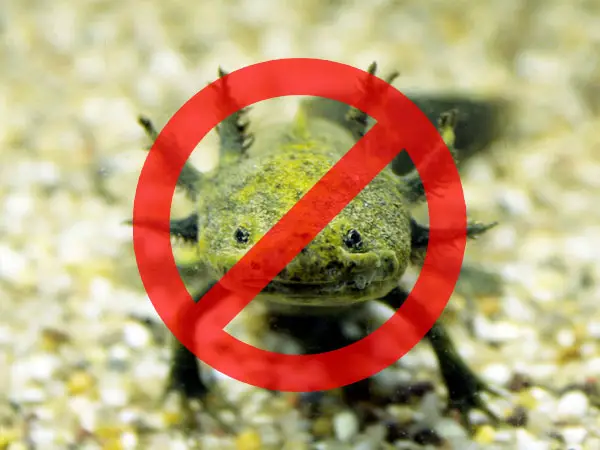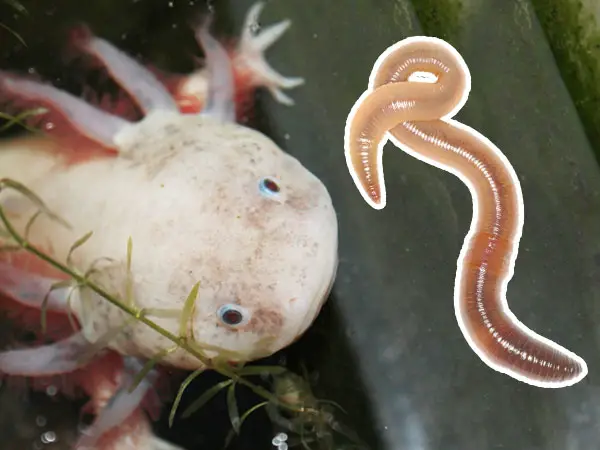
Native to the swampy waters and canals of Lake Xochimilco, Mexico City, axolotls have a carnivore diet made up of any small animal they can fit into their mouths.
By examining the diet of axolotls in the wild, we can make sure that axolotls raised in captivity are fed a similar diet rich in meaty foods.
With axolotls being on the verge of extinction, it’s important that we take good care of our axolotl pets and that includes making sure their nutritional needs are met.
In this article, I’m going to discuss what axolotls eat in the wild, what to feed axolotls in captivity, and which is the best food to feed axolotls.
Axolotl Diet in the Wild
The waters of Lake Xochimilco offer axolotls a variety of meaty foods including insects, worms, slugs, snails, small crustaceans, crickets, mosquito larvae, even small fish and other small salamanders and frog tadpole, as well as other small animals found in the lakes of Xochimilco.
Axolotls have rudimentary teeth that allow them to snap down on their food but not to chew it or tear it. Therefore, you won’t see an axolotl chewing on its food. Instead, axolotls feed by opening their mouth and sucking in water along with their food.
Without the ability to chew, they swallow their food whole. This means that any food they eat must fit into their mouths and they must be able to swallow their food whole.
Axolotls are nocturnal animals, meaning they hunt for prey at night and hide in the deep waters during the day. You may notice this same behavioral pattern even in axolotls kept in your aquaria.
As you can imagine, there are a lot of different meaty foods axolotls have access to in the wild and it’s important that they are fed a similar diet rich in proteins in captivity too.
What to Feed Axolotls in Captivity
Drawing from what we know about what axolotls eat in the wild, we can draw up a similar diet for them in captivity too.
You can feed them earthworms (nightcrawlers) as a highly nutritional option, but they’re best sourced from organic gardens where no chemicals are used.
Apart from earthworms, there are numerous water-based food sources that you can feed axolotls, namely daphnia, bloodworms, blackworms, brine shrimp, tubifex.
With water-based food sources you’ll need to be very careful as they can carry parasites and parasitic infections that they can pass on to your axolotls.
Whenever possible, I recommend that you grow your own cultures (e.g. you can easily make your own brine shrimp cultures) or source these foods from fish-free waters.
Alternatively, if available, you can opt for freeze-dried food options, however, these don’t pack the same nutritional value as live foods, but they also don’t carry parasites or infections.
Although haven’t tried so myself, I’ve also heard aquarists feeding their axolotls small pieces of beef heart.
Still, because beef heart isn’t a food option that axolotls would otherwise have access to in the wild, I would only recommend it as an occasional snack and not something part of their daily diet.
You can also use sinking soft salmon pellets, which pack a good nutritional punch and it’s more readily available.
What is the Best Food for Axolotls?
When it comes to the diet of axolotls, some foods are better than others. For starters, live food sources are more nutritious than pellets or frozen and freeze-dried options.
Nightcrawlers are the go-to choice for many aquarists when it comes to feeding axolotls highly nutritious and protein-rich foods.
Make sure to cut them up into smaller pieces when feeding to your axolotls as they may be too large to be swallowed whole by your axolotls.
I also recommend that you wash earthworms before feeding them to your axies to get rid of earth and other dirt.
Live brine shrimp is another great staple food for axolotls, especially baby axolotls. You can easily make your own culture, which I recommend over commercially available brine shrimp.
If you’re raising more than one axolotl in the same aquarium, make sure you offer them a variety of meat-based foods since not all axolotls enjoy all types of foods the same way.
Remember that juvenile axolotls exhibit cannibalistic tendencies, therefore, it’s best if they’re raised separately or tanks with enough space to discourage cannibalistic tendencies.
How Often to Feed Axolotls?
When it comes to axolotl feeding frequency, you may be surprised to find out that they don’t require frequent feedings. Feeding your axolotl with 1-2 earthworms every other day is enough.
In fact, otherwise healthy adult axolotls can go up to 2 weeks without food. Baby axolotls, on the other hand, require daily feedings since they are still developing and have a lot of growing up to do.
It’s important not to overfeed axolotls. On the one hand, overfeeding raises their waste production, which in turn messes with the water chemistry and raises toxicity in the tank, on the other hand, overfeeding can cause constipation and obstruction.
Make sure you remove any uneaten food from the aquarium and perform regular water changes to remove toxins. Axolotls are sensitive to ammonia and nitrite, so you’ll need to keep their levels at 0 ppm.
Conclusion
Axolotls in the wild feed on whatever live animals they can find and fit into their mouths. Axolotls are carnivores and should be fed a carnivore diet in captivity as well.
When feeding your axolotls, it’s important to source their food from reliable places. To this end, make sure that earthworms are sourced from gardens where chemicals aren’t used or grow your own earthworms.
Similarly, water-based foods (daphnia, brine shrimp, bloodworms, etc.) should either be sourced from fish-free waters or from your own cultures, when possible.
Water-based food sources can carry diseases and parasites, which can easily infect your axolotls too.
While axolotl population in the wild are at an all-time low, hopefully efforts to rehabilitate their natural habitat are met with success and axolotls can once again thrive in the lakes of Xochimilco.




